Mount Suribachi’s flag-raisers step out of their iconic photograph as less and more than heroes in Clint Eastwood’s new movie, Flags of Our Fathers.
By Tom Huntington
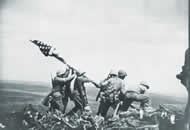 Sergeant Mike Strank went ashore with the first assault on the Japanese-held island of Bougainville on November 1, 1943. By the time he returned home on furlough to the steelmaking community of Franklin Borough, Pennsylvania, in February 1944, Strank was a changed man. He had lived the horror of the infamous no-holds-barred fighting that awaited America’s marines on every Japanese-held island in the Pacific. “I doubt if I’ll ever see you again, ” he told a friend. “I don’t think I’ll be coming back.”
Sergeant Mike Strank went ashore with the first assault on the Japanese-held island of Bougainville on November 1, 1943. By the time he returned home on furlough to the steelmaking community of Franklin Borough, Pennsylvania, in February 1944, Strank was a changed man. He had lived the horror of the infamous no-holds-barred fighting that awaited America’s marines on every Japanese-held island in the Pacific. “I doubt if I’ll ever see you again, ” he told a friend. “I don’t think I’ll be coming back.”
Strank didn’t come back. He died during the bloody battle to take the Pacific island of Iwo Jima. On February 24, 1945, fragments from an exploding shell—probably from a US destroyer—ripped through his chest.
Strank died without knowing he would become an American icon. The day before his death, he and five other men had raised an American flag atop Mount Suribachi, the extinct volcano that overlooked Iwo Jima’s killing fields. Marines had put up a smaller flag hours earlier, but Associated Press photographer Joe Rosenthal was on the scene with his camera ready for the second flag-raising. The image became the most famous photograph of World War II and the most reproduced photographic image in world history.
Now director Clint Eastwood is telling the story of the photo and the men in it with Flags of Our Fathers, his film adaptation of the book James Bradley co-wrote with journalist Ron Powers. The film is due in theaters this October. He is also directing a companion piece called Red Sun, Black Sand that will focus on Iwo Jima’s Japanese defenders.
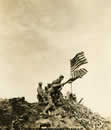 Bradley’s and Powers’s evocative story of the horrors of war and the price of fame became a bestseller upon its release in 2000, causing a fresh surge of interest in the story of the Mount Suribachi flag-raising and the men it turned into national heroes. “Six boys,” wrote Bradley of the flag-raisers. “They form a representative picture of America in 1945: a mill worker from New England; a Kentucky tobacco farmer; a Pennsylvania coal miner’s son; a Texan from the oil fields; a boy from Wisconsin’s dairy land, and an Arizona Indian.”
Bradley’s and Powers’s evocative story of the horrors of war and the price of fame became a bestseller upon its release in 2000, causing a fresh surge of interest in the story of the Mount Suribachi flag-raising and the men it turned into national heroes. “Six boys,” wrote Bradley of the flag-raisers. “They form a representative picture of America in 1945: a mill worker from New England; a Kentucky tobacco farmer; a Pennsylvania coal miner’s son; a Texan from the oil fields; a boy from Wisconsin’s dairy land, and an Arizona Indian.”
The Wisconsin boy was Bradley’s father, John, a Catholic boy from Appleton, Wisconsin, who was working his way toward becoming a funeral director when he joined the navy in an attempt to avoid fighting land battles. Later he was transferred to field medical school and became a naval hospital corpsman, still in the navy, but attached to the marines.
Franklin Runyon Sousley, a likeable, good-humored boy with a widowed mother, hailed from Hilltop, Kentucky. He joined the marines in 1944 to keep from being drafted into the army. Harlon Block of Rio Grand Valley, Texas, was the son of a devout Seventh-Day Adventist mother who deplored the violence of war. Block joined the marines against his mother’s wishes so he could fight alongside his high school buddies.
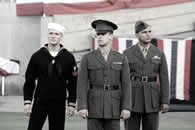 Ira Hayes was a true American, a Pima Indian from a reservation at Gila River, Arizona. Silent and shy, he enlisted in the marines in 1942. Rene Gagnon, a good-looking young man of French-Canadian descent, came from the opposite side of the country. He was born in Manchester, New Hampshire. His parents divorced when he was an infant, and he was raised by his strong-willed mother. He was working in the mills when his draft notice arrived in May 1943. Like Sousley, he joined the marines to avoid being just another grunt in the army.
Ira Hayes was a true American, a Pima Indian from a reservation at Gila River, Arizona. Silent and shy, he enlisted in the marines in 1942. Rene Gagnon, a good-looking young man of French-Canadian descent, came from the opposite side of the country. He was born in Manchester, New Hampshire. His parents divorced when he was an infant, and he was raised by his strong-willed mother. He was working in the mills when his draft notice arrived in May 1943. Like Sousley, he joined the marines to avoid being just another grunt in the army.
Strank was already a veteran marine by the time the other five joined the service. He was born Mychal Strenk in Czechoslovakia and came to America at the age of three, when his mother joined his father in Pennsylvania. He was not a US citizen, but he joined the marines in 1939 and developed into a leader. He knew the ropes and seemed to promise the soldiers under his command some degree of safety amid the chaos of battle.
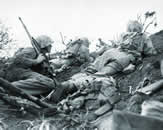 The fates of these six young men entwined on a tiny island called Iwo Jima. It was a barren smudge in the Pacific, a wasteland whose name meant “Sulfur Island,” from the noxious material left over from its volcanic origins. Overlooking the porkchop-shaped piece of land from its southern end was 556-foot-tall Mount Suribachi. Its heights were just as barren and inhospitable as the rest of Iwo’s windswept desolation. One thing Iwo Jima did offer the Americans was a sanctuary for B-29 bombers that would bomb Japan and for their fighter escorts. The Japanese had already finished two airstrips, and construction on a third was underway. “Without Iwo,” said Major General Curtis LeMay, “I couldn’t bomb Japan effectively.”
The fates of these six young men entwined on a tiny island called Iwo Jima. It was a barren smudge in the Pacific, a wasteland whose name meant “Sulfur Island,” from the noxious material left over from its volcanic origins. Overlooking the porkchop-shaped piece of land from its southern end was 556-foot-tall Mount Suribachi. Its heights were just as barren and inhospitable as the rest of Iwo’s windswept desolation. One thing Iwo Jima did offer the Americans was a sanctuary for B-29 bombers that would bomb Japan and for their fighter escorts. The Japanese had already finished two airstrips, and construction on a third was underway. “Without Iwo,” said Major General Curtis LeMay, “I couldn’t bomb Japan effectively.”
Iwo also possessed considerable symbolic value. Although 660 miles from Tokyo, it was administered by Tokyo’s city government. It was a little piece of the Japanese homeland. Capturing it would be symbolic victory indeed, but Japanese resistance would be furious.
Taking the island would be the job of the marines’ 4th and 5th divisions, with the 3rd remaining in reserve. The three divisions totaled about 70,000 men. Supporting them would be almost 800 naval vessels—carriers, cruisers, destroyers, transports, and all the support ships. Total military personnel involved in the operation numbered about 250,000.
Lieutenant General Tadamichi Kuribayashi commanded the 21,000 Japanese defenders. He had spent time in America and realized the futility of waging war against it. “I went around the States, and I knew the close connection between the military and industry,” he wrote. “I saw the plant area of Detroit too. By one button push, all the industries will be mobilized for military purposes.” Still, his Japanese code of honor required that he fight to the end in a bloody war of attrition that would kill as many Americans as possible. “Once the enemy invades the island,” he ordered his men, “everyone will resist until the last moment, making his position his tomb.”
In preparing for an invasion, Kuribayashi’s soldiers burrowed into the island’s guts of soft volcanic rock and created a complex warren of tunnels, bunkers, and caves. As American bombs and shells rained down on the island in pre-invasion bombardments, the Japanese hunkered down in their underground complex and waited for the landings, when they planned to slaughter the marines.
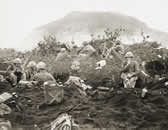 The skies were bright blue, the seas slightly choppy when the first wave of marines and amphibious tractors hit Iwo Jima at 9:02 on the morning of February 19, 1945, only two minutes behind schedule. Planners had assumed the marines would have an easy time advancing from the beaches, but the landing areas were steeply terraced and made of loose volcanic sand, so wheeled vehicles could not gain a foothold. Marines had to carry many supplies by hand through the shifting sands of the steep terraces. Other than that, the landings were deceptively easy, because Kuribayashi’s strategy was to wait before unleashing a barrage into the concentrated Americans. Around 10 a.m., the Japanese guns opened up.
The skies were bright blue, the seas slightly choppy when the first wave of marines and amphibious tractors hit Iwo Jima at 9:02 on the morning of February 19, 1945, only two minutes behind schedule. Planners had assumed the marines would have an easy time advancing from the beaches, but the landing areas were steeply terraced and made of loose volcanic sand, so wheeled vehicles could not gain a foothold. Marines had to carry many supplies by hand through the shifting sands of the steep terraces. Other than that, the landings were deceptively easy, because Kuribayashi’s strategy was to wait before unleashing a barrage into the concentrated Americans. Around 10 a.m., the Japanese guns opened up.
For the next month, Iwo Jima was not just a living hell; it was “a nightmare in hell,” in the words of war correspondent Robert Sherrod. The stories—of severed limbs and splattered entrails and bodies blasted into pieces—remain horrifying today. A marine remembered seeing a leg, still wearing a combat boot, bleeding into the sand. Another marine had to run onto the beach through the guts of the man before him, who had been blown to pieces when a Japanese bullet hit the gasoline tanks of his flame-thrower. “Nowhere in the Pacific war had I seen such badly mangled bodies,” Sherrod wrote. “Many were cut squarely in half. Legs and arms lay 50 feet away from the body.” One marine noted that the beaches were littered with Valentine’s Day cards men had received in the last mail before the invasion.
Among the men who hit the beaches on the first day were the flag-raisers. They all belonged to Company E—Easy Company—of the 28th Regiment’s 2nd Battalion. Rene Gagnon was a member of the 3rd Platoon, to which John Bradley was attached as a corpsman. Strank, Sousley, Block, and Hayes were in the 2nd Platoon.
Their regiment’s mission was to take Mount Suribachi, which was defended by about 2,000 troops with a near-perfect defensive position, hidden away among caves and tunnels on the steep slopes. Somehow the marines advanced through the withering fire, withstanding a ferocious Japanese mortar barrage at the volcano’s base that was “literally raising the earth into the air,” recalled the 3rd Platoon’s lieutenant, Keith Wells. “These explosions were walking up our defense line, every explosion was getting nearer, and I had no place to go. I was sick, sick, sick. The explosions were coming directly up our line with no wasted shells. All I could think about was the great loss of men.”
Despite the horrific shelling, the marines captured Suribachi on the battle’s fifth day, February 23. That morning, Lieutenant Hal Schrier led a 40-man patrol up the volcano. They reached the top around 10 a.m. and faced only token resistance. The marines found a 20-foot length of pipe and used it to raise a small flag on top of the mountain. A marine photographer, Lou Lowery, took photographs of the event before hidden Japanese launched a small firefight, quickly squelched, from hidden caves in Suribachi’s crater.
In the meantime, Strank, Block, Sousley, and Hayes received orders to unwind a telephone line up to the top of Suribachi. Gagnon was told to bring up new batteries for the radio on top. As Gagnon was leaving, Lieutenant Colonel Chandler Johnson handed him a larger flag and told him to take that, too. On top of the mountain, the marines found another length of pipe for Gagnon’s flag.
As the six men raised the flag together, Joe Rosenthal took pictures. Then he had the marines pose beneath the flag for a group shot. Rosenthal had to send his film to Guam to get it developed, and he didn’t see his most famous shot until it had already been published nationwide and acclaimed.
The fighting had been brutal up until the flag-raising, but now it grew even worse. The marines forced their way north up the island and into a rugged section of ridges, hills, and volcanic wasteland they called the Meatgrinder. The Japanese had taken full advantage of the terrain by riddling it with caves, tunnels, pillboxes, blockhouses, and minefields. They made the marines pay a steep price for every advance. Despite the appalling bloodbath, a patrol under Lieutenant Paul Connally finally reached the sea at the island’s north end 18 days after the attack was launched. Connally filled his canteen with salty water and sent it back to Major General Graves B. Erskine with the message “For inspection—not consumption.”
Kuribayashi made his last stand in another natural defensive position on the island’s north end that the marines called the Gorge. The Americans used flame-throwers and flame-throwing tanks the soldiers called “Zippos” to burn the Japanese defenders alive in their positions. “I have 400 men under my control,” Kuryibayashi reported to Tokyo. “The enemy besieged us by firing and flame from their tanks. In particular, they are trying to approach the entrance of our cave with explosives. My men and officers are still fighting.”
The end was near, though. After a month of some of the war’s bloodiest and most brutal combat, the Americans finally secured Iwo Jima. The casualties were horrifying: 5,885 marines were dead and another 17,272 wounded. The navy had lost an additional 881 killed and 1,917 wounded. Of the 21,060 Japanese on the island, almost 20,000 were dead. Thousands of them were never recovered, including Kuribayashi, whose final fate remains unknown.
Strank was the first of the flag-raisers to die. On February 24 he was in a shell hole with his fellow marines, preparing to sketch out an escape route in the sand with his finger when shell fragments ripped through his chest. Block died later that day, torn apart by another exploding shell. On March 21, a Japanese sniper shot Franklin Sousley in the back and killed him.
Of the six, only Bradley, Gagnon, and Hayes survived the war. Once the military had identified them as men in the famous photo, they were whisked back to the United States to take part in a war bonds tour. Suddenly, and for the rest of their lives, they were celebrities.
Movies have always been comfortable with celebrity, but not always with reality. While on that 1944 furlough in Franklin Borough, for example, Strank had taken in a war movie with some friends. “It isn’t really like that,” he told them when it was over. Movies have changed since those days, though. With 1998’s Saving Private Ryan, director Steven Spielberg—who produced Flags of Our Fathers and Red Sun, Black Sand—raised the bar for the realistic depiction of the horrors of war. Disillusion with the political and military process—especially after the Vietnam War—has tempered the heroics on film. Eastwood’s films will certainly not be anything like the John Wayne film Sands of Iwo Jima (see Theater of War on page 68 in this issue).
The story Eastwood seeks to tell in Flags is not just about war. It’s a story about what happens to ordinary people who survived extraordinary circumstances and how they feel about being lionized as heroes when so many of their comrades never came back. “It was sort of the beginning of celebrity in a way,” Eastwood told USA Today. “They felt the heroes were all the people who died over there. They felt terrible about being singled out.”
Eastwood’s search for a location that could stand in for Iwo Jima’s black-sand beaches led him to Iceland, where he filmed some of the landing sequences. The young men on his beaches have names like Andri Sigurdsson, Gunnarr Baldursson, and Markús Benediktsson. Their Icelandic nationality aside, Eastwood wanted to create a realistic picture of Iwo’s marines—especially their youth. “The average age of most of these fellows at that stage was 19, so in casting, I’ll try to be very accurate about that,” Eastwood, who is 75, had said. “The oldest amongst them was 26, in fact, they call him the old man, so if he’s old at 26, well….”
Red Sun, Black Sand will be entirely in Japanese and focus on Kuribayashi, played by Ken Watanabe. Early on, the project aroused debate among the Internet community, which wondered if it was possible to present a sympathetic view of the fanatical Japanese defense of Iwo Jima. Before filming, Eastwood met with Tokyo’s governor to obtain Japanese cooperation for the project. Iwo Jima reverted to Japanese control in 1968 and today the island is administered again by Tokyo. According to reports, the governor asked Eastwood to show proper respect for Iwo Jima’s Japanese defenders. Eastwood agreed and received permission to film some exteriors on the island.
One man with a personal interest in Eastwood’s projects is Rene Gagnon, Jr., who hopes Eastwood treats his father better than Bradley’s book did. Gagnon, Jr., was especially irritated by the way Bradley portrayed his father as a man who eagerly sought the limelight. “Like a moth, Rene was attracted to the flame of fame,” Bradley wrote. Gagnon, Jr., says “I just didn’t appreciate that….” Gagnon, Sr., did participate in commemorative events and make speeches as one of the famous flag-raisers, his son says, “but my father, on every event, said, ‘You know, I didn’t do anything. I went into battle, and somebody said, “Can you bring this flag up to the top of the hill?” We put it up and the next thing I know I’m whisked out of there and I’m a hero. But I didn’t do anything to become a hero.’”
If he had expected to achieve fame and fortune through Rosenthal’s photo, Gagnon, Sr., didn’t find it. Like Bradley, he married his high school sweetheart, but it was a troubled marriage. Gagnon died in 1979. His wife, Pauline, died last January. When Gagnon, Jr., went through her belongings, he was surprised to find a cache of about 100 letters his father had written to her during the war. He and his son, Joshua, hope to publish them in a book. “It brings out a whole different perspective for me,” Gagnon says about the letters. The first ones, written from the marine boot camp at Parris Island, are from a gung-ho marine. By the end of the war, Gagnon says, the man writing the letters has been hardened by the realities of war. “Ironically, he’s got a letter that he wrote to my mother the day after they raised the flag, and he doesn’t mention a thing about it,” says Gagnon. “It’s ‘Sorry I haven’t written for a few days, we’ve been pretty tied up here….’ And it was dated and postmarked the day after the flag-raising.”
The famous photograph didn’t bring happiness to Hayes, either. Hayes had an uneasy relationship with his fame, and he died in 1955 after a downhill spiral into depression and alcohol abuse.
Bradley’s story was happier. Although plagued by nightmares after the war, he was the one flag-raiser who managed to salvage a normal life after the war. He almost never talked about Iwo Jima and the photograph that had made him an icon. When he died in 1994, his family never even knew that he had won the Navy Cross for his actions on the island.
With Bradley’s death the last of Iwo Jima’s flag-raisers was gone. Rosenthal’s photograph remains behind, a reminder of what those six men achieved—and lost—on a tiny island called Iwo Jima.
Photo credits: National Archives, except the color movie still, which is courtesy of Paramount Pictures.
Copyright 310 Publishing, LLC. All rights reserved.



FOLLOW US »
